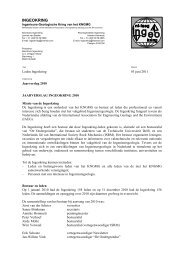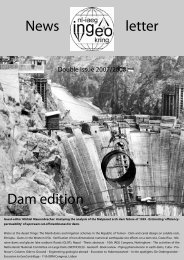environment
environment
environment
- No tags were found...
Create successful ePaper yourself
Turn your PDF publications into a flip-book with our unique Google optimized e-Paper software.
Ingeokring Newsletter<br />
ENVIRONMENT<br />
Environmental Friendly Roads in Bhutan:<br />
Providing access to rural communities while<br />
protecting the <strong>environment</strong><br />
Hendrik Visser (Civil Engineer Delft University of Technology)<br />
Bhutan<br />
The Kingdom of Bhutan, or the land of the thunder<br />
dragon, has an area of approximately 38,394 square<br />
kilometres. It has borders with the Tibetan autonomous<br />
region of China in the north and India in the east, west<br />
and south. Geographically Bhutan lies within the<br />
latitudes 26°45' N and 28°10'N and longitudes 88°45'E<br />
and 92°10' E.<br />
The climatic conditions vary due to the mountainous<br />
nature of the country. The country is subject to the<br />
monsoon rain in summer, with relatively dry winters.<br />
About 73 percent of the land area is covered by forests<br />
of temperate and sub-tropical species that are a natural<br />
habitat of a diversity of flora and fauna. The country<br />
has one of the richest biodiversity in the world with<br />
about 3,281 plant species per 10,000 square kilometres<br />
and has been declared one of the ten global biodiversity<br />
'hotspots'.<br />
Bhutan is one of the least populated countries in South<br />
Asia. Most of the population is concentrated in the<br />
valleys, while large areas at higher altitudes in the north<br />
of the country are virtually empty except for nomadic<br />
herders. The population was estimated to be 699,000 in<br />
2001, with more than 40 percent of the people below 15<br />
years.<br />
The population is probably growing at between 2.5-3.5<br />
percent per year, putting heavy pressure on natural<br />
resources in the villages and resulting in a high rate of<br />
Figure 1: Countries within the Hindu-Kush Himalayan<br />
migration from rural to urban areas. The current rate of<br />
increase is, however, expected to decline to 1.6 percent<br />
per annum in 2011 and 1.3 percent in 2016.<br />
Approximately 80 percent of the population lives in<br />
villages in an extended family system. The average<br />
household is variously estimated to comprise between<br />
6-8 members, with an average of 43 houses per village.<br />
There are approximately 80,000 landholdings in rural<br />
Bhutan. About 60 percent of farmers own less than 2<br />
hectares, which is usually insufficient to feed the<br />
average size family. Only 7-8 percent of the land can be<br />
cultivated and the population pressure on land and other<br />
figure 2: equipment use<br />
figure 3: controlled blasting<br />
24




